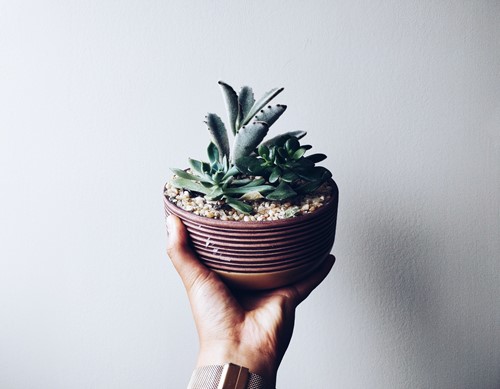
Succulent arrangements make excellent natural decorative pieces. You can grow and maintain them inside and out and use almost anything as a container, making them extremely versatile and an easy way to enjoy the beauty of live plants. While you can purchase many succulent combinations pre-made, sometimes it’s more fun (and more affordable) to make them yourself. Here are some things to consider when choosing succulents to use in your container or planter:
Care Requirements
While succulents all share the same basic characteristics, some of them differ dramatically in the details of required care. Succulents and cacti have plump leaves and limbs in order to store moisture during long periods without water. This makes them drought-tolerant and low-maintenance for watering. However, different succulents need different amounts of water or at different frequencies. Those with thinner leaves prefer more water than those with especially thick leaves.
Other care details to consider are light and temperature requirements. Some succulents thrive in harsh, full sunlight. Others prefer shade or only partial light and will get burned under full sun. There are some varieties of succulent that can withstand frost and freezing temperatures, but most will perish if left exposed to harsh winter weather. When choosing succulents to plant in an arrangement, make sure they have similar needs so they thrive together.
Dormant Seasons
Besides light, temperature and water needs, succulents also differ in dormant seasons. A dormancy period is the opposite of a growth period, meaning growth will slow or stop completely. It can also mean dropping leaves or other signs of the plant shedding excess matter to conserve energy. While most succulents do not look dramatically different when dormant, they do have different care needs. When succulents or cacti are dormant, decrease your watering by at least half. Some varieties prefer you not water them at all until the turn of the season.
This matters to your arrangement choices primarily because of ongoing maintenance. If some succulents are dormant while others are not, it’s easy to accidentally over-water or overexpose the sleeping plants while taking care of the active ones. This can lead to root rot, sunburn and other problems.
Color & Shape
Choosing succulents for your arrangement based on their color, size and shape is the fun part of the planning process. Succulents appear in a rainbow of colors and some even change color depending on environmental conditions. Some also grow with variegation in their leaves, a rare type of mutation that appears in multiple colors or even patterns like stripes. In terms of color, there are a few strategies for picking the right plants. Analogous color schemes include colors next to one another on the color wheel, while complementary colors would be opposite. With green and red being extremely common succulent colors, the latter is easy to accomplish.
For shape, size and texture, you have just as many options. You can combine tall, spiky succulents like aloe and haworthia with flat rosette shapes like echeveria. There are even trailing succulents like sedum and crassula that will spill over the edges of a container. With so many plants to choose from, you will create a beautiful arrangement no matter what you combine.
About the Author

Teresa Boyd
From the beaches to the links and everything in between - I'd love to assist you on your property search.
I began my real estate career here in Ocean Isle Beach in 2006, and each year since I have been recognized as a multi-million dollar sales agent and have consistently been one of the top producers at Coldwell Banker Sloane Realty.
If you are thinking about buying or selling, let me guide you home.
